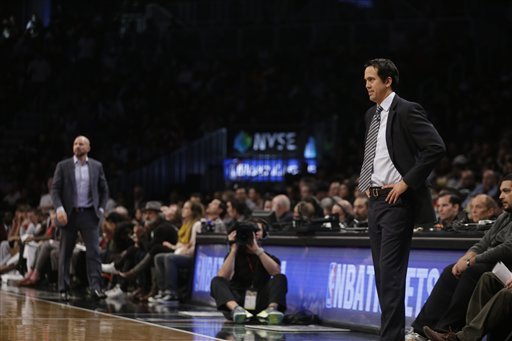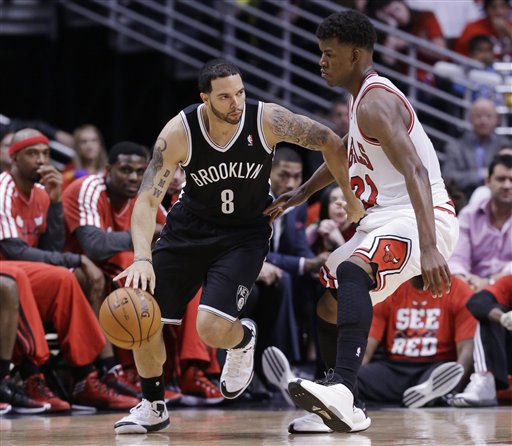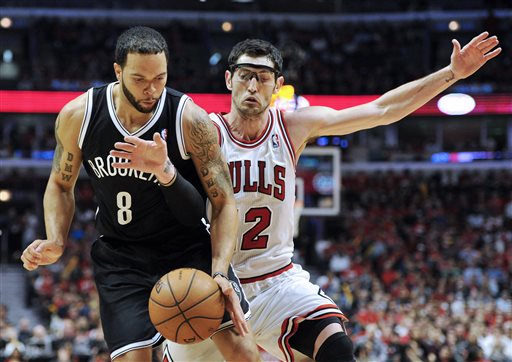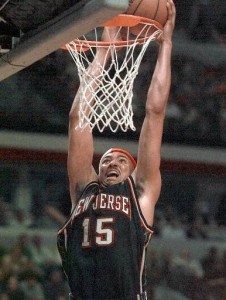
In our final run at the greatest Nets by position, Mark & I rank the worst historical position for New Jersey: the good ol’ man in the middle. There are some good players here, and that’s about as nice as I can be.
Without further ado:
5. Sam Bowie
(told you.)
Regular Season: 280 G, 3,578 points (12.8), 2,304 rebounds (8.2), 551 assists (2.0), 154 steals (0.6), 459 blocks (1.6), .436 FG%, .286 3P%, .762 FT%, 15.0 PER
Playoffs: 7 G, 47 points (6.7), 31 rebounds (4.4), 11 assists (1.6), 9 steals (1.3), 4 blocks (0.6), .429 FG%, .500 3P%, .714 FT%, 8.9 PER
It’s almost befitting for a player best known as being one of the biggest draft blunders ever for being picked on spot ahead of the great player of all-time, should end up on a list of “best” Nets of all-time. But fortunately, in this case, the Nets are not the Portland Trailblazers, and the fact that Sam Bowie was drafted before Michael Jordan in the 1984 draft should not be held against him as it pertains to his Nets career.
In his three seasons of New Jersey, Bowie was the model of NBA average, putting up a PER (player efficiency rating) of 15.0. He did deal with some of the injury issues that ended up plaguing him throughout his career (playing a large part in what has made him such a spectacular draft bust), but when he did suit up, Bowie was always good for double digits points, 8 boards and a couple of blocks per game. With more electric players like Derrick Coleman, Drazen Petrovic and Kenny Anderson around him, that’s all the Nets ever needed.
Additionally, Bowie could step back and drill a 15-footer almost on cue, and he even snuck in a handful of three-pointers during his Nets tenure. I always missed Bowie when the Nets finally gave up on his injury issues and instead went with noted malcontent Benoit Benjamin in 1993-94. Obviously, no one is ever going to really get over the fact that someone picked this guy with bum knees ahead of Michael Jordan, but there’s nothing wrong with celebrating a player for being perfectly acceptable. -M.G.
4. Nenad Krstic
Regular Season: 226 games, 2,551 points (11.2), 1,290 rebounds (5.7), 238 assists (1.1), 83 steals (0.4), 167 blocks (0.7), .492 FG%, .111 3P%, 715 FT%, 13.7 PER
Playoffs: 15 games, 235 points (15.7), 105 rebounds (7.0), 15 assists (1.0), 6 steals (0.4), 12 blocks (0.8), .520 FG%, .739 FT%, 14.9 PER
The Nets took Krstic with the 24th pick in the 2002 NBA draft, and after two years of stalling overseas came to join the Nets in ’04. He started almost immediately, and made a quick impact as a 21-year-old by showing a nice touch inside and a reliable jumper that stretched the floor in ways Jason Collins couldn’t.
Krstic gets the edge over Bowie for 4 reasons: 1) Bowie’s 15-footer was reliable, but Krstic’s was more so, and his multitude of offensive skills made him a reliable option on the floor next to Collins, even though both were natural centers; 2) Krstic didn’t shy away in the playoffs, even putting up a couple of nice games in the same paint Shaq patrolled in 2005 and 2006, Bowie had a grand total of 0 memorable games for the Nets in the postseason; 3) Bowie only had one season you could really classify as “good” in a Nets uniform (1992), Krstic improved each season in New Jersey, playing at an all-star level in 2006 before his awful ACL injury; and 4) “Nenad” was one of my many nicknames in high school, “Bowie” was not.
Okay, so that last one isn’t a real reason (though it is true). Pick your favorite of the first three. They all still apply, I promise. -D.K.
3. Darryl Dawkins
Regular Season: 258 G, 3,687 points (14.3), 1,412 rebounds (5.5), 361 assists (1.3), 159 steals (0.6), 385 blocks (1.5), .601 FG%, .286 3P%, .706 FT%, 16.1 PER
Playoffs: 17 G, 273 points (16.1), 95 rebounds (5.6), 22 assists (1.3), 11 steals (0.9), 23 blocks (1.4), .580 FG%, .000 3P%, .837 FT%, 17.5 PER
Like a few other players who have made these “top five” lists the past few weeks, Darryl Dawkins, aka, Chocolate Thunder, is probably better known for his NBA career prior to his stint in New Jersey. With his electrifying dunks, Dawkins shattered a backboard with Philadelphia in 1979, leading to the league adopting breakaway rims.
By the time the Nets acquired him in 1982, Dawkins had developed the reputation as a disappointment. With his unique mix of size, strength and speed, some thought Dawkins would be the next big thing akin to Wilt Chamberlain or Bill Russell. Dawkins consistently averaged double digits points and was among the league leaders in field goal percentage, but many thought he would accomplish more. In 1983-84, Dawkins played a key role in beating the Philadelphia 76ers in the first round – New Jersey’s first ever NBA playoff series victory and the first playoff series in history where the road team won every game – averaging 16.8 points and 6.7 rebounds per game during the postseason. However, he also set a dubious record during the regular season, when he committed 386 personal fouls.
By 1984-85, injuries derailed Dawkins career and after appearing in only 6 games in 1986-87, his Nets career came to an end. His NBA career ended a few seasons later. Dawkins and his unrealized potential have remained a curiosity – playing with the Harlem Globetrotters and gaining national headlines for his match-ups against Manute Bol in the Continental Basketball Association (CBA) in 1995-96. -M.G.
2. Mike Gminski
Regular Season: 550 games, 6,415 points (11.7), 3,671 rebounds (6.7), 711 assists (1.3), 317 steals (0.6), 599 blocks (1.1), .473 FG%, .000 3P%, .834 FT%, 16.5 PER
Playoffs: 20 games, 214 points (10.7), 115 rebounds (5.8), 16 assists (0.8), 14 steals (0.7), 26 blocks (1.3), .514 FG%, .791 FT%, 18.2 PER
In seven seasons in New Jersey, Mike Gminski was the ultimate role player: at his best when he didn’t have to lead. The antithesis to Darryl Dawkins, Gminski didn’t run or jump so much as he lumbered and lurched. His tough defense, combined with the impeccable beard he fashioned later in his Nets career, did nothing to dispel the rumors that Gminski was secretly part lumberjack.

His playoff numbers are, like his game, solid yet unspectacular. He ranks #2 on this list almost by default; the guy played 550 games in a Nets uniform, never had any major injuries, was a key part of five Nets playoff teams, and made the most of his playing time once he became a full-time starter in 1985. Before being traded to the Sixers in January of 1988, Gminski averaged 16.5 points & 8.5 rebounds in 1986 & 1987, ranking as the best two-year stretch by any Nets center not named…
1. Brook Lopez
Regular Season: 246 games, 4,283 points (17.4), 1,862 rebounds (7.6), 402 assists (1.6), 146 steals (0.6), 410 blocks (1.7), .504 FG%, .000 3P%, .801 FT%, 19.1 PER
Playoffs: N/A
Firstly: the fact that Lopez ranks as the best center in Nets history speaks as much to Lopez’s abilities as it does to the historical dearth of talent that the Nets have had at the center position for over 40 years.
There’s no doubt that Lopez is a talented player still scratching the surface of his potential. His rebounding allergy is a concern – his 10% rebound rate puts him at the league average of all players, not just centers. Players ahead of him last year include the 6-7 Matt Barnes, the 6-6 Quentin Richardson, and the 6-4 Dwyane Wade. But without missing a game in three seasons (nor a start in 239 consecutive games), he still played his strongest ball at the end of 2011, averaging season highs of 25.8 points per game on 54.4% shooting in the final month.
For the first time in Nets history, they’ve got a center they can rely on for 20 efficient points per night. When healthy, it’s possible they’ll be able to rely on a lot more. He’s never had one year where he puts it all together, and if he’s fully healthy next season (whenever it starts), it may be his last chance in a Nets uniform. -D.K.


















